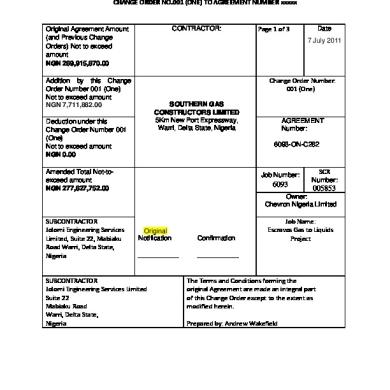Techpapertemplate.pdf
This document was uploaded by user and they confirmed that they have the permission to share it. If you are author or own the copyright of this book, please report to us by using this DMCA report form. Report DMCA
Overview
Download & View Techpapertemplate.pdf as PDF for free.
More details
- Words: 879
- Pages: 11
The following template should be used as a guide in preparing your 2,500 word technical paper for the Certified Cost Consultant (CCC)/Certified Cost Engineer (CCE) exam. While this template may be useful in ensuring your technical paper will incorporate all structural areas to be evaluated by technical paper graders, you will be responsible to demonstrate professional content, clarity, and relevance through your topic and writing skills, which are also evaluated by the graders. For assistance in selecting a title, writing an abstract, addressing your audience, and writing an effective body and other important factors, we recommend that you read “How to Write a Technical Paper,” by James D. Whiteside, II, PE listed on our website. All technical papers must be submitted to [email protected] by the final registration deadline of the examination date you have selected. If you have any questions, please contact the Certification Department at 304‐296‐8444.
i
CCC/CCE Certification Technical Paper Template (Rev. 2011‐08‐23) The Title of the Paper Date Written AACE Membership Number
ii
Table of Contents List of Tables
iii
List of Figures
iv
Abstract
v
Introduction
Pg. # Pg. #
The Problem
Pg. #
Topic 1
Topic 2
Resolution of Problem
Pg. # Pg. # Pg. # Pg. # Pg. # Pg. # Pg. # Pg. #
Conclusion
Bibliography
Pg. # Pg. # Pg. # Pg. # Pg. # Pg. # Pg. # Pg. # Pg. # Pg. #
iii
List of Tables Table 1, “Title 1”
Table 2, “Title 2”
Table 3, “Title 3”
Pg. # Pg. # Pg. #
iv
List of Figures Figure 1
“Figure 1 Title”
Figure 2
“Figure 2 Title”
v
Pg. # Pg. #
List of Equations Equation 1
“Equation 1 Title”
Equation 2
“Equation 2 Title”
vi
Pg. # Pg. #
Abstract The purpose of an abstract is to entice potential customers to purchase the material or attend the presentation. Abstracts between 100 to 175 words are generally well received. Longer abstracts tend to be short versions of the material. This template is formatted to have the correct automated numbering: Roman numerals starting on page two (Table of Contents) and Arabic numerals starting with the Introduction page.
vii
Introduction The introduction should be designed to attract the reader’s attention and give an idea of the paper’s focus. The Problem or Introduction Discuss the background of the problem to set the stage for the intent of the paper. Topic 1 “This is how a reference is to be made throughout the paper.” [1] (content needs to be placed within quotes and referenced by a corresponding number, just as illustrated.) Term X^6 X^5 X^4 Display Plot 3E‐09 ‐9E‐07 0.0001 Data Plot 2.95E‐09 ‐3.5E‐05 0.17007
X^3 X^2 X^1 Constant ‐0.0057 0.1715 ‐2.4906 13.776 ‐444.84 654440 ‐5.13E+08 1.68E+11
Table 1—Polynomial Coefficient Comparison (source referenced)
1
Figure 1 — Average Percent Inflation vs Year (source referenced) This is an example of a figure. Figures and tables must be legible. Titles in graphs, figures, and table should also be kept to 6‐8 words (source must be referenced). Equations When using an equation such as the example that follows, show the equation and then explain each of the variables from left to right. When text is read from left to right, the reader can easily follow the variable explanation from top to bottom. dS/S = exp (μ X (dT) + std X Є X (dT)1/2)) exp = the inverse of LN, the natural logarithm of number dS = change in the variable’s value from one step to the next S = previous value μ = the annualized growth or average increase between steps 2
Eq 1
dT = change in time from one step to the next std = annualized volatility, or standard deviation Є = value from a probability distribution (Monte Carlo) Conclusion A conclusion should clearly demonstrate everything promised in the abstract has been accomplished. Whatever was identified in the introduction or statement of the problem section of the paper has been addressed. And using this template will greatly enhance the review process of AACE.
3
Bibliography No. Description 1 Breyfogle, III, F 1999 Chapter 9, Six Sigma Measurements Implementing Six Sigma: Smarter Solutions Using Statistical Methods First Edition Pages(s)144 John Wiley & Sons, Inc., New York 2 Whiteside, II, PE, J. 2009 DEV.01—How to Write a Technical Presentation 2009 AACE International Transactions AACE International, Morgantown, WV EXCEPTION: If the author has a legal paper and wishes to use legal in‐line referencing, then the author must request, in writing, a waiver and may be asked to submit an example. In‐line referencing that is not formatted in the way used in legal papers will be denied. In‐line referencing will not be allowed as an alternative to footnoting. Examples: MCI Constructors, Inc., DCCAB No. D‐924, 1996 WL 331212 (D.C.C.A.B. 1996) (awarding contractor loss of productivity damages for the interruption to its rhythm and sequence of contract work resulting from owner‐caused delays, changes and accelerations) See also United States Indus., Inc. v. Blake Constr. Co., 671 F.2d 539 (D.C. Cir. 1982) (holding that a subcontractor is entitled to recover damages where a contractor’s failure to properly schedule and coordinate a subcontractor’s work activities led to lost productivity) WEB REFERENCES ARE ONLY ALLOWED IF A PDF FILE OF THE DOCUMENT REFERENCED IS INCLUDED WITH THE MANUSCRIPT.
4
More Documents from "Engr Mathy Onosemuede"

Change Order No. 01-fully Executed.docx
April 2020 10
Onshore Pipelines.pdf
April 2020 13
Techpapertemplate.pdf
April 2020 14
C282-fully Executed Change Order No. 03.pdf
April 2020 9
Estimate For Fire Fighting System Design.docx
April 2020 12